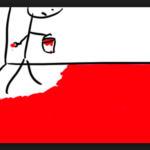The main focus of my research on the Sphere of Subjectivity is on the self-control skills children learn with the internalization of language. Jane Loevinger did not study children, but extrapolated back the themes adults expressed with their sentence completion that indicate a fixation on a younger unresolved stage of development. Whereas self-control tends towards avoiding the behaviors that would bring disapproval, with “self-protection” there is less self-control and more effort to hide disapproved behavior. For most people (those who are not extremely rich), this usually does not lead to social success and sustainable happiness (the rich may be able to continue to be successful, but that does not translate into happiness).
In the following strip, Calvin intends to build an impenetrable fort, but finds that he has ultimately trapped himself.
One should never hem oneself in without planning an escape route. This brings to mind another metaphor: painting oneself into a corner.
 Of course, another way to protect oneself is to throw snowballs (as Calvin often does at Susie), or paintballs (the more current sport): of course, if Calvin’s fort was successful, he would have a full armament of snowballs with a way of making sure Susie had to go by that route at least 2X/day.
Of course, another way to protect oneself is to throw snowballs (as Calvin often does at Susie), or paintballs (the more current sport): of course, if Calvin’s fort was successful, he would have a full armament of snowballs with a way of making sure Susie had to go by that route at least 2X/day.
